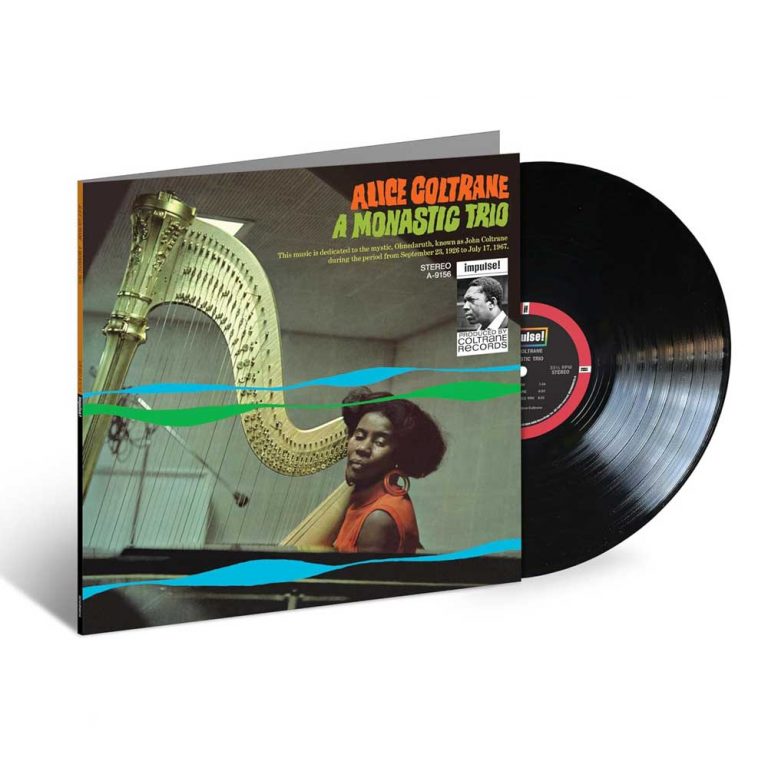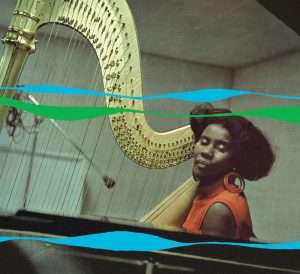The young pianist from Detroit, Alice McLeod, first met John Coltrane around 1963. The couple were married in 1965 and Alice became a member of what would be John’s last band after replacing McCoy Tyner on piano at the beginning of 1966.
She was with John in his intense final months as they embarked both deeper into the free-jazz avant-garde and on an ever more sincere spiritual quest to find a universal sound with the potential to heal humanity. When John Coltrane died of cancer at the age of 40 in July 1967, it didn’t just mean the cruel curtailment of a heartfelt musical and spiritual mission. In Alice, he also left behind a widow a month shy of her 30th birthday, caring for four young children.
Yet somehow, amidst the sorrow, she found the strength to keep the music going. “A Monastic Trio” was Alice Coltrane’s first release as a leader, recorded at the studio she had built at their home in Dix Hills, New York. As the name suggests, it was created after a brief period of retreat and contemplation, after which Alice emerged with a very clear vision of what she was aiming to do. It was only the first of several groundbreaking recordings Alice made in the studio.

For one thing, it served as a loving tribute to her deceased husband. The album’s cover states that it is “dedicated to the mystic, Ohnedaruth, known as John Coltrane,” referencing the spiritual title (Sanskrit for ‘compassion’) that John adopted towards the end of his life. It was also very much intended as a continuation of his work. In the liner notes, Alice states that she aims to “play music according to the ideals set forth by John and continue to let a cosmic principle, or the aspect of spirituality be the underlying reality behind the music.”

ALICE COLTRANE A Monastic Trio
Available to purchase from our US store.To realise this, Alice called upon musicians with strong ties to John Coltrane. The album’s opening track, “Ohnedaruth” (recorded in January 1968, just six months after John’s passing). features saxophonist Pharoah Sanders and bassist Jimmy Garrison – both of whom had worked alongside Alice in John’s final band – plus drummer Ben Riley. The rest of the album, recorded in June 1968, features the titular trio of Alice, Garrison on bass, and another alumnus of John’s final group, drummer Rashied Ali. Yet, as well as being a consolidation and extension of John’s aesthetic, the album also gives a very clear indication of the direction in which Alice would take her own music in the years ahead.
On Side A of the record, Alice plays piano, with a feel that is very much rooted in the blues and gospel. “Ohnedaruth” begins with a leisurely blues cadenza before dissolving into a more agitated freedom, with Sanders overblowing a shrieking bass clarinet and Alice dropping plunging chords. “Gospel Trane” is a nifty stroll with the bass and drums neatly in the pocket, building a firm foundation for a questing piano solo. Concluding Side A, “I Want To See You” is a freely floating piece only just held together by gossamer threads. But even here, Alice’s extremely light and swift piano extemporisations are grounded by left hand chords that seem to connect her to the earth.
On Side B, Alice unveils the harp that John bought for her, but which only arrived at Dix Hills after he died. Alice is self-taught and practically invents a new language for the harp in an avant-jazz setting – a wash of heavenly cascades and cosmic swirls that fill all the available space, suggesting a heart brimming over with transcendent love. The bass and drums are restrained and sensitive, with Garrison moved to contribute some sweetly tuneful accompaniment. On “Lovely Sky Boat,” an introductory arco bass drone gives way to a deep modal vamp with light-footed drums skipping around the metre and Alice’s harp rippling mellifluously. This is the first glimpse of the simultaneously groove-based and ethereal vibe she would go on to perfect with “Journey In Satchidananda” in 1971.
With “A Monastic Trio”, Alice Coltrane announced the blueprint for the deeply felt spiritual jazz that flourished in the late 1960s and 1970s in the space left by John Coltrane’s passing. It remains an apex and an archetype of devotional music.

ALICE COLTRANE A Monastic Trio
Available to purchase from our US store.Read on… Alice Coltrane: The Artist in Ascension
Daniel Spicer is a Brighton-based writer, broadcaster and poet with bylines in The Wire, Jazzwise, Songlines and The Quietus. He’s the author of a book on Turkish psychedelic music and an anthology of articles from the Jazzwise archives.


